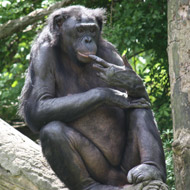
Babies and bonobos vocalise in a similar manner
Wild bonobos vocalise in a similar manner to human infants, a study by UK and Swiss psychologists has found.
The study, published in Peerj, reveals that wild bonobos - our closest living relatives - produce vocalisations in a wide range of emotional states and situations, similar to baby humans.
The scientists say that the findings challenge how we think about the evolution of communication and potentially move the dividing line between humans and other apes.
It was previously thought that animals only usually communicate using calls that are tied to emotional states, such as to express aggression or to warn about potential predators. In contrast, humans use a single vocal signal in a variety of situations - referred to as 'functional flexibility'.
However, when researchers from the University of Birmingham, UK, and the University of Neuchatel, Switzerland, conducted research on wild bonobos, they found that the species produces a call type, known as the 'peep', across a range of positive, negative and neutral situations, such as during feeding, travel, rest, aggression, alarm, nesting and grooming. Peeps are high-pitched vocalisations which are short in duration and produced with a closed mouth.
They discovered broad similarity in the acoustic structure across different contexts suggesting that the call had contextual flexibility. Similar to human infants, recipients have to make sensible judgements about the meaning of the call.
Commenting on the study, Dr Zanna Clay from the University of Birmingham said that "more research needs to be done on our great ape relatives before we can make conclusions about human uniqueness. The more we look, the more continuity we find among animals and humans"
Image (C) Ltshears



 BSAVA is to partner with BVA Live (11-12 June 2026) to champion clinical research.
BSAVA is to partner with BVA Live (11-12 June 2026) to champion clinical research.